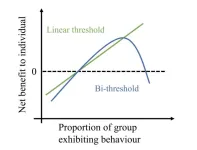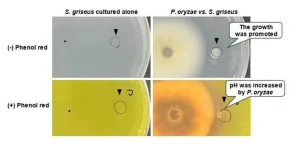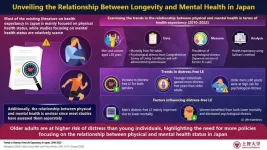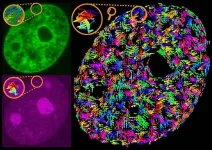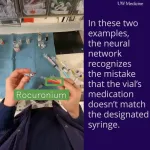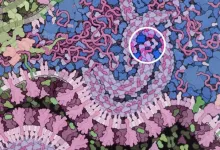(Press-News.org) A model of human behavior finds that people will share information if enough—but not too many—of their contacts do so. Humans are social creatures, and many behaviors and beliefs can spread from person to person. Understanding the dynamics of behavioral diffusion can help encourage healthy or sustainable behaviors or stop the spread of misinformation. Linear threshold models assume that people will adopt a behavior when the number of their social contacts that have done so passes a threshold. Pouria Ramazi and colleagues propose an addition to the model, in which people drop a behavior when the number of their contacts who have adopted the behavior passes a second threshold. Periods of decline in the adoption of innovations, fashions going out of style, and gossip becoming stale are among the reasons why a second threshold for behavioral adoption might exist. The authors test their theory using the social media conversations on Twitter (now X) around the Higgs boson and the Melbourne Cup horse race, as well as conversations in China on Weibo about the COVID-19 vaccination campaign. In each case, the bi-threshold model outperformed the linear-threshold model. According to the authors, the results confirm the existence of the second upper threshold in some contexts of diffusion of information.
END
A model for the decline of trends, fads, and information sharing
2024-10-22
ELSE PRESS RELEASES FROM THIS DATE:
Plastic mulch is contaminating agricultural fields
2024-10-22
Using plastic sheets for weed control, even under current best management practices, pollutes soil with macro- and micro-plastics and negatively affect critical soil functions, according to a study. The United Nations considers soil plastic contamination an environmental health and food security threat. Around the world, over 25 million acres of farmland is seasonally covered with opaque plastic films used as “mulch” to prevent weeds, retain moisture, and warm soil—a practice known ...
Scientists discover how fungi interact with soil actinomycetes
2024-10-22
In the world of agriculture, rice is a staple food for more than half of the global population, making its cultivation crucial for food security. However, the rice blast fungus Pyricularia oryzae (syn. Magnaporthe oryzae) poses a significant threat to rice crops, causing extensive damage and leading to substantial yield losses. Traditional methods of controlling this pathogen often rely on chemical fungicides, which can have detrimental environmental impacts and contribute to the development of resistant strains. Therefore, researchers are increasingly exploring alternative strategies that leverage natural ...
Beyond longevity: The critical role of mental health in Japan’s well-being
2024-10-22
The Japanese population is known for its longest life expectancy (LE) at birth. Extensive studies have been conducted on the physical health of the Japanese population, mainly on mortality outcomes. However, research on mental health is limited due to the social stigma against mental illnesses. This is alarming since mental health problems such as anxiety, substance use disorders, and suicide rates have largely increased over the years.
Additionally, previous studies have examined the physical and mental health of the Japanese population separately, which makes it harder to understand the relationship between them.
Against this backdrop, Associate Professor Yuka Minagawa ...
Stirred, not shaken — Scientists uncover how transcription drives motion within the genome
2024-10-22
A team of scientists has discovered surprising connections among gene activity, genome packing, and genome-wide motions, revealing aspects of the genome’s organization that directly affect gene regulation and expression.
The findings, reported in the journal Nature Communications, bolster our understanding of the mechanics behind transcription-dependent motions of single genes—the dysfunction of which may lead to neurological and cardiovascular disorders as well as to cancer.
“The genome is ‘stirred’ by transcription-driven ...
Engineering creates molecules that target cancer-causing proteins
2024-10-22
For some proteins, a single mutation, or change in its DNA instructions, is all it takes to tip the balance between functioning normally and causing cancer. But despite causing major disease, these slightly mutated proteins can resemble their normal versions so closely that treatments designed to target mutants could also harm healthy cells.
Led by researchers at NYU Langone Health and its Perlmutter Cancer Center, a new study describes the development of a biologic, a drug derived from natural biological systems, that targets a mutant cancer protein called HER2 (human epidermal growth factor receptor 2) without attacking ...
Wearable cameras allow AI to detect medication errors
2024-10-22
A team of researchers says it has developed the first wearable camera system that, with the help of artificial intelligence, detects potential errors in medication delivery.
In a test whose results were published today, the video system recognized and identified, with high proficiency, which medications were being drawn in busy clinical settings. The AI achieved 99.6% sensitivity and 98.8% specificity at detecting vial-swap errors.
The findings are reported Oct. 22 in npj Digital Medicine.
The system could ...
New bacterial toxins discovered: A key to fighting infections
2024-10-22
Researchers have discovered a new group of bacterial toxins that can kill harmful bacteria and fungi, opening the door to potential new treatments for infections. These toxins, found in over 100,000 microbial genomes, can destroy the cells of bacteria and fungi without harming other organisms. The study revealed how some bacteria use these toxins to compete with other microbes, and the findings could lead to new ways to fight infections, especially as antibiotic resistance becomes a growing concern.
A new ...
AI eye to eye with ophthalmologists in diagnosing corneal infections, study finds
2024-10-22
Eye care specialists could see artificial intelligence help in diagnosing infectious keratitis (IK), a leading cause of corneal blindness worldwide, as a new study finds that deep learning models showed similar levels of accuracy in identifying infection.
In a meta-analysis study published in eClinicalMedicine, Dr Darren Ting from the University of Birmingham conducted a review with a global team of researchers analysing 35 studies that utilised Deep Learning (DL) models to diagnose infectious keratitis.
AI models ...
Virginia Tech researcher works to preserve the white shark in the Mediterranean Sea
2024-10-22
The Mediterranean Sea is a paradise.
Pristine waters and an incredible coastline spanning multiple continents that are renowned the world over.
Below those picturesque, and sometimes crowded, waters swim a legendary creature facing a treacherous and uncertain future: the white shark.
Francesco Ferretti, an assistant professor in the College of Natural Resources and Environment, is working to save one of the most endangered white shark populations on the planet. The research team located signs of the remaining white sharks ...
How the coronavirus defeats the innate immune response
2024-10-22
The novel coronavirus SARS-CoV-2 has an enzyme that can counteract a cell’s innate defense mechanism against viruses, explaining why it is more infectious than the previous SARS and MERS-causing viruses. The Kobe University discovery may point the way to the development of more effective drugs against this and possibly similar, future diseases.
When a virus attacks, the body’s immune response has two basic layers of defense: the innate and the adaptive immune systems. While the adaptive immune system grows stronger against a specific pathogen as the body ...
